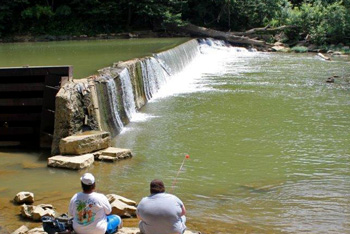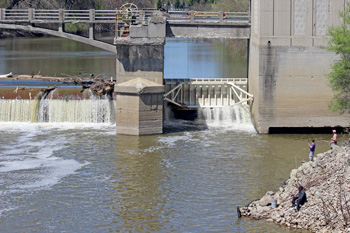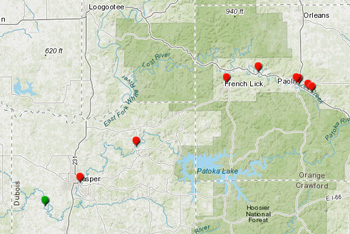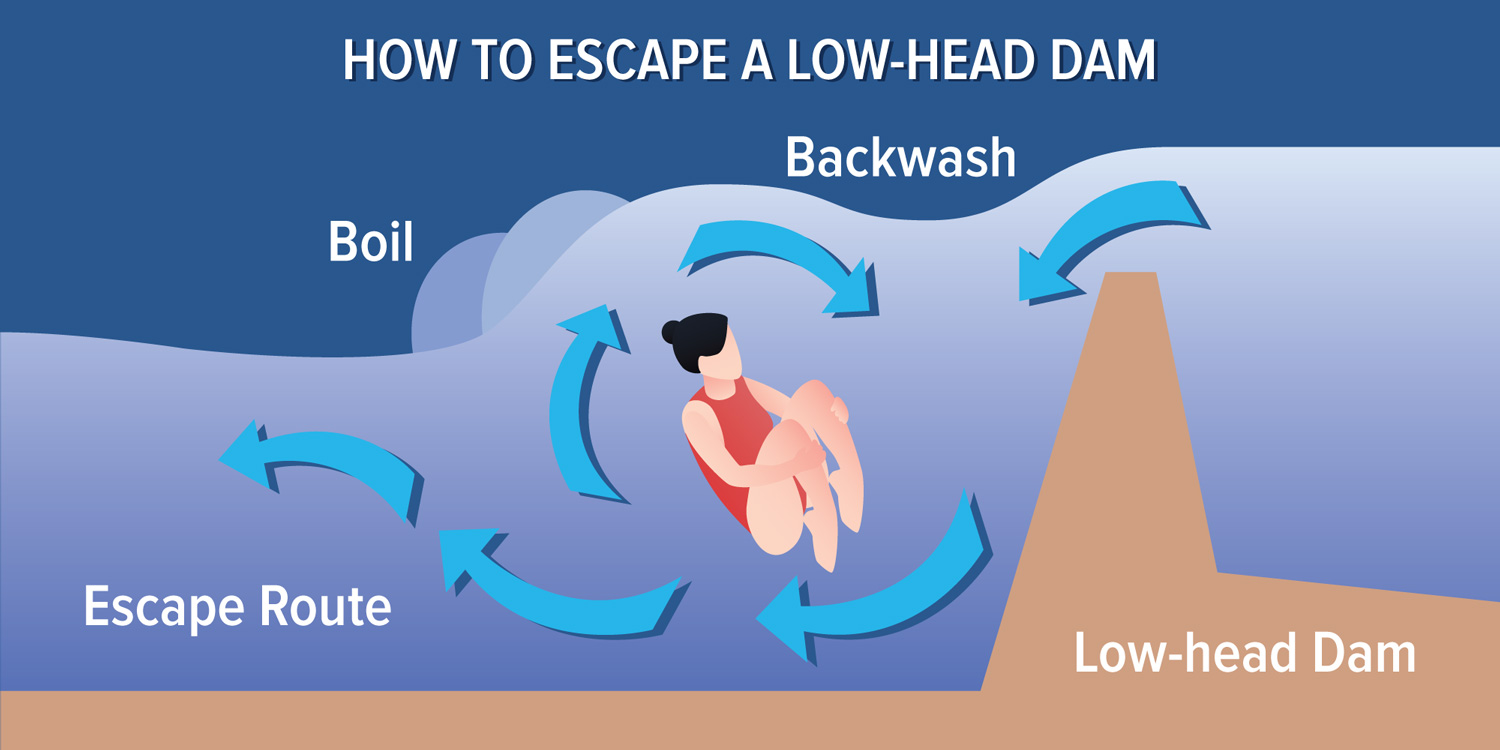Low-Head Dams
- Get Prepared
- General Safety
- Current: Low-Head Dams
April is Low-Head Dams Public Safety Awareness Month
May 31 is National Dam Safety Awareness Day
In March 2020, the Indiana legislature passed House Bill 1099, which prohibits people from accessing low-head dams and the waters within 50 feet of the dams when warning signs are present, among other provisions. For National Dam Safety Awareness Day on May 31, the Indiana Department of Homeland Security (IDHS) urges Hoosiers to learn more about low-head dams, where they are and to avoid them.
What Is a Low-Head Dam?
A low-head dam is a manmade structure spanning a river or stream channel in which water flows over the entire length of the top of the dam. Moderate-to-high currents flowing over these dams create strong turbulent and recirculating forces that can pull and trap individuals underwater. These dams typically range from a 1- to 15-foot drop. Because of their relatively small size and drop, low-head dams may not always appear to be dangerous.
Low-Head Dam Safety Tips
Quick Tips
- Be aware of any low-head dams in the area where you are boating or swimming.
- Always wear a personal flotation device when boating or swimming.
- Stay away from low-head dams. It is almost impossible to escape them if you get caught.
- If caught below a low-head dam, tuck your chin into your chest, draw your knees up and wrap your arms around them.
- If someone else is trapped, call 911. Perform shore-assisted rescue if possible, but do not get into the water to save the person. Many dam-related deaths are from people who were trying to rescue someone who was trapped.

Recreational Safety
A reoccurring theme of dam-related deaths is that victims had been recreating nearby and were unaware of the power of the water, especially when the water level was up, which only enhances dangerous water velocities and the risk of unseen obstructions. The churning action below low-head dams is dangerous for swimming, boating, fishing and other water recreational activities. When recreating in a natural body of water, such as a river, be aware of the distance from any low-head dams. It is possible to be caught in a low-head dam while moving upstream or downstream.
There are more than 150 low-head dams cataloged in Indiana. Hoosiers who boat and swim in stream systems are encouraged to learn where low-head dams are located before going so they can be avoided. In many cases, low-head dams are difficult to see from upstream, which can cause an unsuspecting people to go over the dam and place themselves in danger.
Always wear a personal flotation device (PFD) when recreating in a natural body of water. If recreating near water, bring ring buoys, boat cushions or one-gallon milk jugs filled halfway with water and tied to 50 feet of rope. Using any of these items can help retrieve a person caught in a low-head dam without putting a rescuer in danger. When kayaking or canoeing, always pick up and carry the vessel around low-head dams.
If Caught in a Low-Head Dam
It is nearly impossible to escape the recirculating current of a low-head dam without assistance. If caught in the boil of a low-head dam, tuck your chin into your chest, draw your knees up and wrap your arms around them. By doing so, conditions may push you out of and away from the hydraulic current, along the streambed. After swimming away from the current, try to swim along the face of the dam towards the nearest bank.
If you see someone trapped in a low-head dam, call 911 immediately. Whether on shore or in a kayak or other boat, do not jump in to save the person, and do not approach the hydraulic current. Stand on the bank and shout encouragement to the individual until help arrives. The most effective and safest form of rescue is shore-assisted. Shore-assisted rescue will not put the rescuer at risk. It is important to note that more than 25 percent of dam-related deaths are the rescuers themselves who do not succeed in saving the person drowning (source: Indiana DNR).

Low-Head Dam Facts
- Between 2010 and May 2020, IDHS documented reports of 25 people who have died in Indiana near or at low-head dams.
- The average age of deceased victims in dam-related incidents from 2010 to May 2020 was 33.
- Across Indiana from 2010 to May 2020, at least 17 people were injured and more than 50 people were rescued at dams (all types).
- The age range of dam-related deaths in Indiana is between 6 and 73 years of age (2010 to May 2020).
Resources
Videos
- "Be a Dam Champion"
Association of State Dam Safety Officials - "DNR: Stay Away From Low-Head Dams at Any Cost"
WTIU - "Don't Give a Dam Your Life"
WFYI - “Over, Under, Gone: The Killer in Our Rivers”
WFYI
Websites
- Dam-Safety Conference
Association of State Dam Safety Officials - Dams and Levees in Indiana
Indiana Department of Natural Resources - Keep Your Distance, Keep Your Life
Association of State Dam Safety Officials - House Bill 1099: Low-Head Dams
Indiana General Assembly - How to Escape Low-Head Dam
Indiana Department of Homeland Security - National Dam Safety Awareness Day
Association of State Dam Safety Officials - Public Safety Around Dams
Association of State Dam Safety Officials


